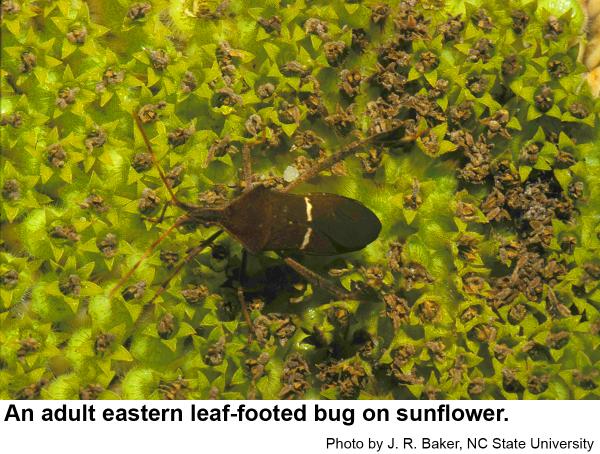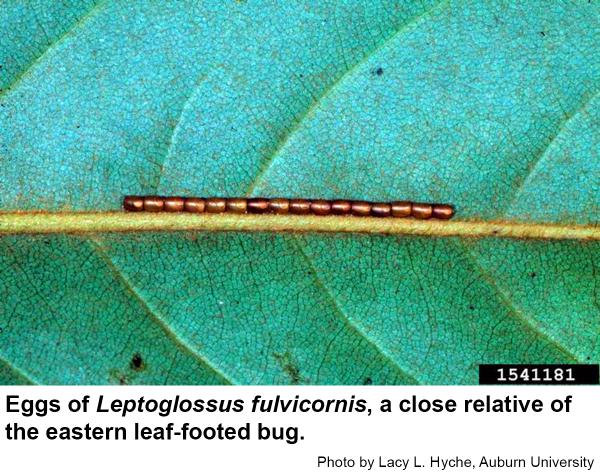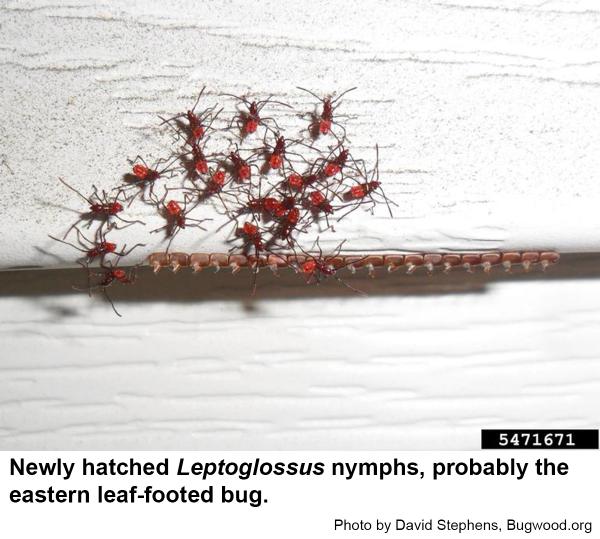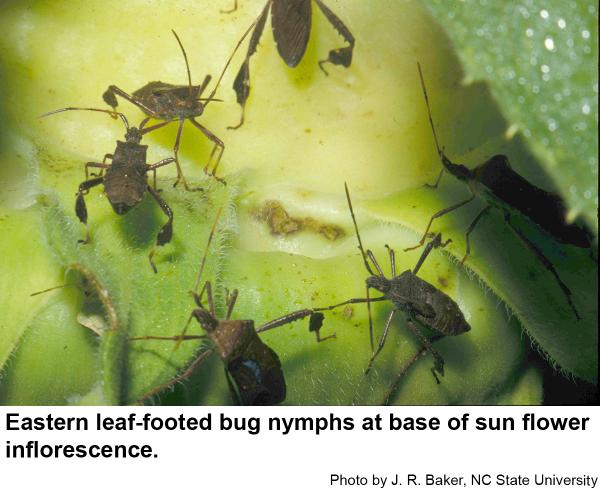Description and Biology
Bugs in the genus Leptoglossus are named leaf-footed bugs because part of the hind leg is wide and flat and more or less resembles a leaf. These leaf-like expansions are reputed somehow to aid males in “fighting” for females. Leaf-footed bugs are 1/2 to 3/4 inch long and the eastern leaf-footed bug, Leptoglossus phyllopus, often has a noticeable white line across the back of its wings. The bugs emit a distinctive odor from scent glands on the thorax. Eggs are fastened end to end in a small, golden-brown line of cylindrical eggs of about 20 on twigs or along a leaf vein. Eggs are preyed upon by fire ants and the snowy tree cricket, Oecanthus fultoni. At least three species of tiny wasps parasitize eggs as well. Eastern leaf-footed nymphs resemble adults except that nymphs are smaller, and nymphs do not have wings. Very young nymphs have red bodies. Also, the hind legs of nymphs are completely slender. Eastern leaf-footed bugs often aggregate into large groups. One plant may be swarming with bugs while a neighboring plant has none. Several generations occur each year in North Carolina.
Host Plants
Leaf-footed bugs are plant feeders and are sometimes common pests in the vegetable garden, but they also kill back the tips of roses and ruin the seeds of sunflowers. Leaf-footed bugs also feed on and ruin pecan nuts, and they damage peaches and plums. Leaf-footed bugs even feed on in pine cones where they weaken or destroy developing seeds. Other plants infested include apple, bean, beargrass, bell pepper, blueberry, blackberry, cowpea, crape myrtle, cucurbits, eggplant, Gerbera daisy, gladiolus, grain sorghum, hibiscus, ligustrum, loquat, oat, okra, peach, pear, persimmon, plum, potato, tomato, and, to a lesser extent, rye, wheat, barley, and soybean. Eastern leaf-footed bugs also infest elderberry, goldenrod, jimsonweed, and thistle.
Residential Recommendations
Leaf-footed bugs are susceptible to insecticidal soaps as well as pyrethroid pesticides labeled for homeowner use in landscapes. When used as directed, pyrethroids are very toxic to insects but are not particularly hazardous to humans and pets (other than fish-avoid using pyrethroids around pools, ponds, and streams). Such pesticides are available in most garden sections of big box stores. If only a small group of bugs are a problem, they can be dislodged into a jar of soapy water in which they will drown in agony.
References
- Parasitism and Predation on Eggs of Leptoglossus phyllopus (L.) (Hemiptera: Coreidae) in Cowpea: Impact of Endosulfan Sprays. J. Agric. Abudulai, M., B. M. Shepard, and P. L. Mitchell. 2001. Urban Entomol. 18(2): 105–115.
- Common name: leaffooted bug, scientific name: Leptoglossus phyllopus (Linnaeus) (Insecta: Hemiptera: Coreidae). Mead, F. W. 2016 (revised). Featured Creatures, University of Florida, IFAS, Entomology & Nematology, FDACS/DP, EDIS, Publication Number: EENY-72.
- Eastern Leaf-footed Bug – (Leptoglossus phyllopus). Staff Writer. 2015. Insect Identification for the Casual Observer.
- Extension Plant Pathology Publications and Factsheets
- Horticultural Science Publications
- North Carolina Agricultural Chemicals Manual
For assistance with a specific problem, contact your local N.C. Cooperative Extension Center.
This Factsheet has not been peer reviewed.
Publication date: July 4, 2016
Reviewed/Revised: Sept. 16, 2019
Recommendations for the use of agricultural chemicals are included in this publication as a convenience to the reader. The use of brand names and any mention or listing of commercial products or services in this publication does not imply endorsement by NC State University or N.C. A&T State University nor discrimination against similar products or services not mentioned. Individuals who use agricultural chemicals are responsible for ensuring that the intended use complies with current regulations and conforms to the product label. Be sure to obtain current information about usage regulations and examine a current product label before applying any chemical. For assistance, contact your local N.C. Cooperative Extension county center.
N.C. Cooperative Extension prohibits discrimination and harassment regardless of age, color, disability, family and marital status, gender identity, national origin, political beliefs, race, religion, sex (including pregnancy), sexual orientation and veteran status.




